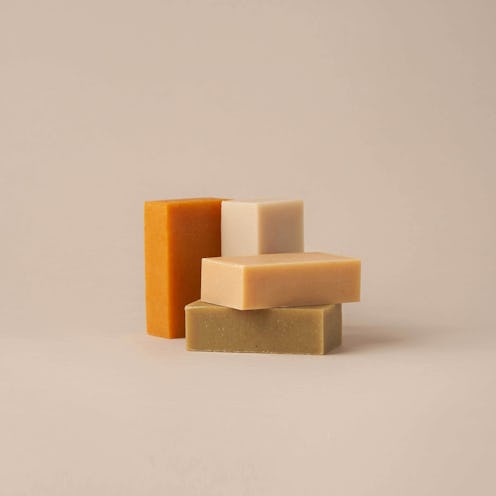(Beauty)
The Unlikely Benefit To Ditching Your Go-To Shampoo

The ingredient taking over beauty routines everywhere isn’t retinol, or vitamin C, or even hyaluronic acid. It’s plastic. Go ahead, check your top shelf: The majority of your bottles, jars, pumps, and applicators are probably fashioned out of the same material that accounts for 300 million tons of waste per year. Luckily, brands are taking note of beauty’s big little plastic problem, and now offer plenty of eco-friendly alternative: Luxe glass jars, refillable lipsticks, and — my personal favorite — shampoo bars that require almost zero packaging.
Swapping out your trusty bottle of liquid shampoo for a solid bar may feel counterintuitive at first, if only because “bar soaps” have a reputation of being harsh on skin and hair. But that’s a non-issue with the latest crop of innovative solid shampoos, many of which feature gorgeous natural oils (like sunflower and castor) and hydrating butters (like shea and mango) alongside moisture-binding glycerin. The result? Smooth, shiny hair that looks and feels healthy — and is healthy for the planet, too.
“The main difference between shampoo bars and liquid shampoos is the lack of water in bars,” Dr. Caroline Robinson, MD, a board-certified dermatologist who specializes in scalp care, tells The Zoe Report. Not only does eliminating water allow for more concentrated products that “take up less space and are easier to travel with,” per the dermatologist, it also allows for fewer potentially harmful ingredients. “Our initial inspiration was to create a water-free option so that we could avoid preservative use,” Tara Pelletier, the co-founder of Meow Meow Tweet, tells TZR of her brand’s cult-favorite shampoo bars and just-launched conditioner bar. Both products boast just 10 ingredients — almost all of which are carrier oils, butters, and essential oils. In short: Shampoo bars have fewer “fillers.”
Another major ingredient that’s typically missing from shampoo bar formulations is sodium lauryl sulfate, or SLS. “While it is very effective at removing excess oil and dirt from the scalp and hair, it can be too harsh for some people, particularly those with wavy, curly, or ethnic hair,” Dr. Robinson says. SLS often washes away too much oil, leaving hair “squeaky" clean... but ultimately dehydrated and damaged. “There are many shampoo bars that contain more mild, sulfate-free cleansers, and that are formulated with less additives,” Dr. Robinson confirms — although she says that’s not always the case, so it’s important to carefully read the label of any products you’re considering.
With water and SLS out of the picture, many consciously-created shampoo bars turn to saponified oils and butters. “These are staple ingredients seen in shampoo bars,” the dermatologist says. “Oils and butters provide extra shine, moisture, and slip so that the hair feels more manageable after cleansing.” Both essentially mimic sebum — the scalp’s built-in moisturizing mechanism — to “coat the hair and protect it from additional damage over time.” Dr. Robinson is a fan of sunflower oil for its ability to protect the scalp's skin barrier, castor oil for moisturizing drier hair types, and murumuru butter for a glossy finish.
Glycerin, a natural byproduct of soap production, is also commonly found in hair care bars like the ones from By Humankind and LUSH Cosmetics. “Because of its ability to attract water in humid environments and leave the hair feeling soft, it is often added to shampoos of all types,” Dr. Robinson says. This substance acts as a humectant, drawing moisture from the air into your hair — which can really only be a good thing, right?
Clean ingredients and easy storage aside, shampoo bars’ biggest claim to fame is that they’re better for the environment. Most come wrapped in paper or contained in a small cardboard box, and that’s it — no excess plastic, no over-the-top packaging, nothing to throw away when you’re done. “Hopefully [our bars] will show customers that there are alternatives, and they start putting pressure on bigger brands to make better choices,” Pelletier says. “The thing that will make an impact is larger companies starting to notice the consumer demand for alternatives and offering them.”
As a final word of caution, Dr. Robinson notes that many shampoo bars suggest users apply them directly onto the scalp, which “can lead to increased risk of tangles and knots” for curly and coily types — so lathering up in your hands and then working the shampoo into your roots is fine, too.
Ahead, 12 eco-friendly and hair-healthy shampoo and conditioner bars that’ll help clear some space in your shower (and your recycling bin).